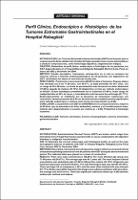| dc.contributor.author | Ichiyanagui, Carlos | |
| dc.contributor.author | Frisancho, Oscar | |
| dc.contributor.author | Yábar, Alejandro | |
| dc.date.accessioned | 2019-04-24T14:20:54Z | |
| dc.date.available | 2019-04-24T14:20:54Z | |
| dc.date.issued | 2010 | |
| dc.identifier.citation | Revista de Gastroenterología del Perú. 2010;30(3). | es_PE |
| dc.identifier.issn | 1022-5129 | |
| dc.identifier.uri | https://hdl.handle.net/20.500.12959/413 | |
| dc.description.abstract | Los Tumores Estromales Gastrointestinales (GIST) son lesiones que se originan a partir de las células intersticiales de Cajal, y pueden tomar cursos asintomáticos o producir complicaciones, como hemorragia digestiva y degeneración maligna. Se presenta un estudio que tuvo como objetivo determinar el perfil clínico, endoscópico e histológico de los pacientes con GIST diagnosticados en el Hospital Nacional Edgardo Rebagliati Martins (Lima-Perú), en enero del 2002 y diciembre del 2004. Se realizó un estudio descriptivo, transversal, retrospectivo en el cual se revisaron las historias clínicas e informes anatomopatológicos de 34 pacientes con diagnóstico de GIST, vertiéndose los datos en una ficha de recolección. El estudio concluye que los pacientes con GIST en el HNERM son en su mayoría varones, mayores de 60 años, que se presentan con dolor abdominal y melena, y es la endoscopía el mejor método para diagnosticarlos si acuden por melena. Predomina la histología fusiforme. | es_PE |
| dc.description.abstract | INTRODUCTION: Gastrointestinal Stromal Tumors (GIST) are lesions which origin from
Intersticial Cells of Cajal that may be asymptomatic or cause complications like digestive
bleeding or malignant transformation.
AIM: To determine the clinical, endoscopic and histological profile, as well as the main
demographic features of patients with GIST in Hospital Edgardo Rebagliati (Lima-Perú)
from January 2002 to December 2004.
METHODS: Descriptive, transversal and retrospective study in which we reviewed clinical
and anatomopathological archives from 34 patients with GIST during the above mentioned
period. The collected data were placed on a sheet of recollection.
RESULTS: There was male predominance (58.82%).The most affected age group was
71-80 years old (26.47%). The average age was 64.7 years old. The most frequent clinical
presentation was abdominal pain (47.06%) followed by melena (44.12%). Diagnosis was
made by endoscopic method in 58.82%. The main histological type was spindle (47.06%).
There was high risk of malignancy in 50% and the most often involved site was stomach
(61.77%). Endoscopicall the characteristic image was a submucosal tumor with ulceration,
the average size was 6.44 cm. There was significant statistical relation (p< 0.05) between
endoscopic method and melena. CONCLUSION: Patients with GIST in HNERM are mostly men, older than 60 years that
come with abdominal pain and melena, being endoscopy the best method to diagnose if
patients present melena. Predominating histology was fusiform. | |
| dc.format | application/pdf | es_PE |
| dc.language.iso | spa | es_PE |
| dc.publisher | Sociedad de Gastroenterología del Perú | es_PE |
| dc.relation.uri | http://www.scielo.org.pe/scielo.php?script=sci_arttext&pid=S1022-51292010000300004 | |
| dc.rights | info:eu-repo/semantics/openAccess | es_PE |
| dc.rights.uri | https://creativecommons.org/licenses/by-nc-nd/4.0/ | es_PE |
| dc.source | Seguro Social de Salud (EsSalud) | es_PE |
| dc.source | Repositorio Institucional EsSalud | es_PE |
| dc.subject | Gastroenterología y Hepatología | es_PE |
| dc.subject | Tumores del Estroma Gastrointestinal | es_PE |
| dc.subject | Gastrointestinal stromal tumours | |
| dc.subject | Mesenchymal tumours | |
| dc.title | Perfil clínico, endoscópico e histológico de los tumores estromales gastrointestinales en el Hospital Rebagliati | es_PE |
| dc.type | info:eu-repo/semantics/article | es_PE |
| dc.subject.ocde | https://purl.org/pe-repo/ocde/ford#3.02.19 | es_PE |
| dc.publisher.country | PE | es_PE |






